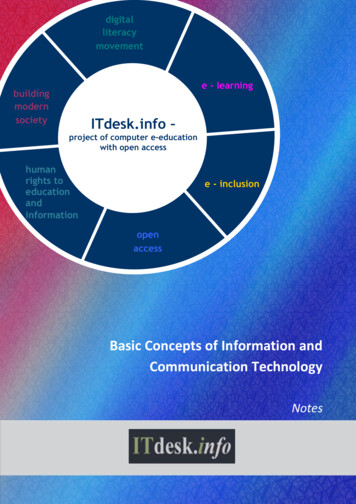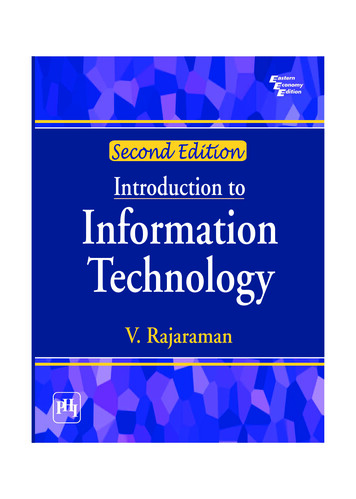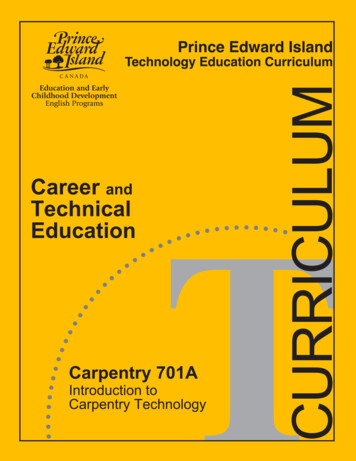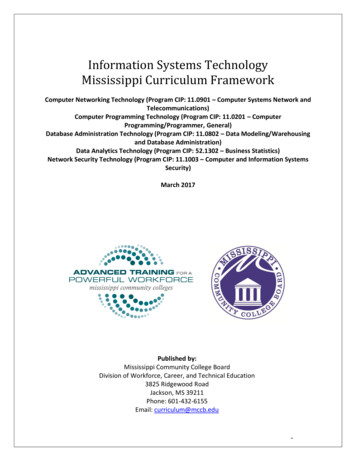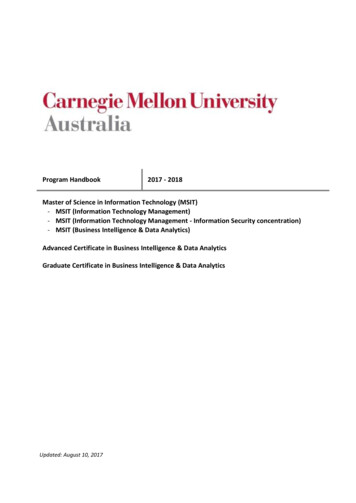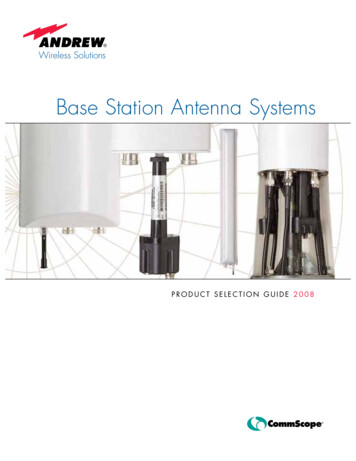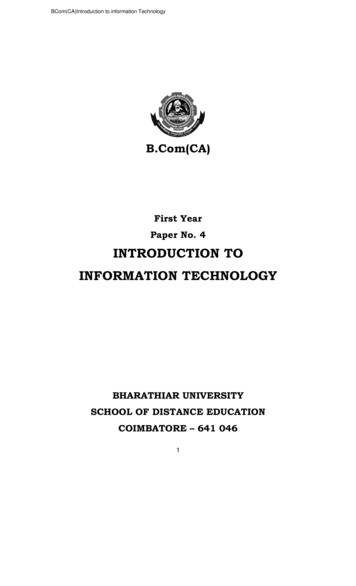
Transcription
BCom(CA)Introduction to information TechnologyB.Com(CA)First YearPaper No. 4INTRODUCTION TOINFORMATION TECHNOLOGYBHARATHIAR UNIVERSITYSCHOOL OF DISTANCE EDUCATIONCOIMBATORE – 641 0461
BCom(CA)Introduction to information Technology2
BCom(CA)Introduction to information TechnologyCONTENTLessonsPAGENo.UNIT-ILesson 1Introduction to Computer Systems7Lesson 2Hardware and Software20Lesson 3Data Processing27Lesson 4Computer Applications37Lesson 5Computers Related Jobs45UNIT-IILesson 6Types of Computer Systems51Lesson 7Generations of Computers63Lesson 8Data Processing System70Lesson 9Networking83UNIT-IIILesson 10Components of Computer and their Functions97Lesson 11Storage Unit and CPU110Lesson 12Software116Lesson 13Programming Language124Lesson 14Program Development132UNIT-IVLesson 15Operating System145Lesson 16Electronic Commerce157Lesson 17Internet164Lesson 18Extranet and E-Mail172Lesson 19Mobile Computing181UNIT-VLesson 20Systems Analysis and Design187Lesson 21Introduction to Information Systems193Lesson 22Office Automation Systems and Transaction Processing207Lesson 23Decision Support Systems220Lesson 24Expert Systems2303
BCom(CA)Introduction to information Technology(Syllabus)B.Com (CA) INTRODUCTION TO INFORMATION TECHNOLOGYObjectives : After the successful completion of the course the students shouldhave knowledge about concepts and principles of IT.UNIT-IHardware and Softward : Computer systems – importance of computers inBusiness – Data and Information – Data Processing, Data Storage and Dataretrieval capabilities – Computer applications in various areas of businesscomputer-related jobs in business.UNIT-IITypes of Computer systems-Micro, Mini, Mainframe and Super Computer.Analog, Digital and Hybrid Computers – Business and Scientific Computersystems – First, second, third and fourth generation Computers, Laptop ornotebook Computers – Data Processing Systems – Batch, Online and Real timesystem – Time sharing, Multiprogramming and Multiprocessing systems –Networking : Local and Wide Area Network.UNIT-IIIComponents of Computers – Input, Output and Storage Devices – Software :System Software and Application Software; Programming Language – MachineLanguage – Assembly Language, Higher Level Languages. Flow Chart andProgramme Flow Chart – Steps in developing a Computer programme.UNIT-IVOperating Systems : Dos, Windows, UNIX, WindowsNT, Windows98E.Commerce. Internet-Extranet-E.mail and its uses-World Wide Websites-MobileComputers.UNIT-VSystem Analysis and Design – Computer – based Information SystemTransaction Processing – Office Automation – Management Information System –Decision Support Systems – Expert System.Book for Reference1. Computer and Common Sense – Roger Hunt and John Shellery2. Using Micro Computers – Brightman and Dimsdale3. P.C.Software Made Simple – R.K.Taxali4. Introduction to Computers – Alexis Leon and Mathews Leon5. Information Technology for Management-Henry C.Lucas4
BCom(CA)Introduction to information TechnologyUNIT – I5
BCom(CA)Introduction to information Technology6
BCom(CA)Introduction to information TechnologyLESSON-1INTRODUCTION TO COMPUTER SYSTEMCONTENTS1.0.Aims & Objectives1.1Introduction1.2Characteristics of Computers1.2.1 Speed1.2.2 Storage1.2.3 Accuracy1.2.4 Versatility1.2.5 Automation1.2.6 Diligence1.2.7 Reliability1.3History of Computers1.3.1 Speed1.3.2 Storage1.3.3 Accuracy1.3.4 Versatility1.3.5 Automation1.3.6 Diligence1.3.7 Reliability1.3.8 Versatility1.3.9 Automation1.3.10 Diligence1.3.11 Reliability1.4Computer System1.5Importance of Computers in Business1.6Let Us Sum Up1.7Lesson End Activity1.8Points for Discussion1.9Check your Progress1.10Reference7
BCom(CA)Introduction to information Technology1.0 AIMS & OBJECTIVESThis lesson the Information Technology concepts through Basic knowledge ofIntroduction to the computer systems. At the conclusion of this chapter youshould be able to understand: The characteristics of computers that makes them an essential part ofevery technology world. Computer system, which includes components such as central processingunit & Input and Output (I/O) device .1.1 INTRODUCTIONThe term computer is derived from the Latin word compute, which means tocalculate. A computer is an electronic machine, devised for performingcalculations and controlling operations that can be expressed either in logical ornumerical terms. In simple terms, a computer is an electronic device thatperforms diverse operations with the help of instructions to process theinformation in order to achieve the desired results. Computer applicationextends to cover huge area including education, industries, government,medicine, scientific research etc.A computer is one of the most influential forces available in modern times. Dueto its memory, high speed and perfection, its application can be extended toalmost infinite levels.Millions of complex calculations can be done in mere fraction of time. Difficultdecisions can be made with accuracy for comparatively little cost. Computers arewidely seen as instruments for future progress and as tools to achievesubstantiality by way of improved access to information by means of videoconferencing and e-mail. Indeed computers have left such on impression onmodern civilization that we call this era as the information age.1.2 CHARACTER STICS OF COMPUTERSThe main characteristics of computers are: Speed Storage Accuracy Versatility Automation Diligence Relbility8
BCom(CA)Introduction to information Technology1.2.1 SPEEDComputers are capable of carrying out the task with enormous speed. Today’scomputers,according to their class, can perform from 4 MIPS (Millions of instructions persecond) to 100 MIPS. What may take days for manual calculations may takeonly a few hours for computers to perform. Inside the computer the informationsignal travels at incredible electronic speed.1.2.2 STORAGEComputers can store enormous quantity of information. Which is expressed interms of Kilobytes (or) Mega Bytes (MB) or Gega Bytes (GB). It is achievedthrough its ‘Main memory’ or ‘Primary storage’ and through ‘auxiliary storage’ or‘Secondary storage’. The Hard disks Floppy disk, Compact Disc(CD) andMagnetic Tape storage are examples of secondary storages. These large volumesof storage occupy much lesser space compared to paper documents and thisaspect of computers makes them more powerful.1.2.3 ACCURACYThe accuracy of a Computer is consistently high. In fact, this quality of thecomputers make them indispensable in various fields such as ScientificResearch, Space Research, Weather Predictions and many other areas whereprecision of a high order is required. The accuracy of the computer is bestachieved by programming them in the most efficient manner. When it comes tovery complex mathematical or scientific problem the computer’s accuracy has nosubstitute.1.2.4 VERSATILITYComputers are versatile in that they can perform almost any task, provided theyare given the appropriate logical steps. For example, they are capable ofperforming wide ranging tasks such as construction of a payroll, inventorymanagement in a factory, hotel billing, hospital management, bankingapplications and any imaginable task in every walk of life.1.2.5 AUTOMATIONThe biggest advantage of computers is that it is automatic in its operation. Oncea programming logic is initiated the computer performs repeated operationswithout human interventions until program completion.9
BCom(CA)Introduction to information Technology1.2.6 DILIGENCEComputers are machines and that do not get tired or ‘lose concentration’ likehuman beings. If a large number of calculations say million calculations are tobe performed the resultant output will remain exactly the same even ifoperations are repeated any number of times. But when a human being is askedto do the same job this consistency cannot be achieved. Thus for those who wantconsistent and continuous standard output, computer’s ‘diligence’ is of greathelp.1.2.7 RELIABILITYThe computers give very accurate results with predetermined values. Theycorrect and modify the parameters automatically, giving suitable signals. Theygive formatted results with high degree of precisions.Check Your ProgressBring out any three characteristics of computerNotes:a) Write your answer in the space given belowb) Check your answer with the one given at the end of this Lesson . . . . .1.3 HISTORY OF COMPUTERSIn the early days of mankind, man used to count the head of cattle by puttinglines on trees. Slowly these lines changed to numbers. To do calculation onnumbers he started inventing machines.1.3.1 ABACUSAbacus was probably the earliest of counting devices. It consists of rectangularwooden frame with two compartments and beads sliding along the steel wires forcounting. Multiplication and divisions are done using repeated additions andsubtractions. Even today in which cross strings are fixed. Beads are inserted onto the strings. There are a number of rows of beads.10
BCom(CA)Introduction to information TechnologyFig 1.11.3.2 NAPIER’S LOGS AND BONESJohn Napier, a Scottish mathematician invented logarithms. The use oflogarithms enabled him to transform multiplications and division problems ofaddition and subtractions. In the beginning he called logarithms as artificialnumbers. But later he named them logarithms.Napier also invented a computing device consisting of sticks with numberscarved on them. These sticks are called bones as they were made of bones.These bones helped a lot in multiplication involving large numbers.Fig : 1.21.3.3 SLIDE RULEAs the name indicates, the slide rule has one scale sliding within the other.Suppose you want to add two numbers 3 and 5, set 3 on the fixed scale andslide the moving scale. So that its “0’ coincides with”5” of sliding scale. This isthe sum of 3 and 5. The process of reading could be quick if you are trained inthe use of slide rule.Fig : 1.311
BCom(CA)Introduction to information Technology1.3.4 CALCULATING MACHINES AND PASCAL’S CALCULATORA French mathematician, Blaise Pascal invented a machine based on gearwheels. He was the son of tax collector who had to do lot of calculations as partof his job. Blaise Pascal wanted to make his job easier by inventing a calculator.You might be familiar with gear wheels in use in your bicycle which meshes witha driving chain. He used similar gear wheels with ten teeth for each digitposition. He fixed them together so that one wheel drives the other. When thewheel corresponding to units position rotated by ten teeth, it drove the wheelcorresponding to the next higher position by one tooth. Thus one could makecalculations. Pascal provided dials, which indicated numbers stored on eachwheel. He also used suitable “dialing system” to operate the gear wheels. Otherpeople also made a number of such calculators. Computer scientists honouredPascal by naming a programming language Pascal after him.Fig : 1.41.3.5 BABBAGE DIFFERENCE AND ANALYTICAL ENGINESBabbage, a British National and the son of a wealthy banker wanted to correctthe errors in the logarithm tables being used during his time. In 1822, he madea machine which calculated the successive difference of expressions (X2 ax bis an example of an expression) and prepared table which helped him in hiscalculations. The royal Astronomical society awarded a gold medal to him for hisinvention and granted a large sum of money to carry out further work. Hewanted to make an accurate calculating machine called “Babbage’s AnalyticalEngine”. The analytical Engine was supposed to be very accurate. So it neededlot of parts made with precision. Babbage could not make such parts. Heconceived that his machine would use input devices, would have a processingpart called “mill” where you can perform calculations, would also incorporateIt consists of rectangular frame in which cross strings are fixed. Beads areinserted on to the strings. There are a number of rows of beads .Since he wasabout 100 years ahead in his ideas, he could not get parts needed for hismachine. This is because there were no tools to make such precision parts. Hedid lot of work related to making precision parts and spend all the grants (andlot of his money too) but failed in his attempt to make a machine. He ultimatelydied as a frustrated man.12
BCom(CA)Introduction to information TechnologyFig : 1.5Fig : 1.61.3.6 LADY ADA LOVELACELovelace is the daughter of the famous English poet Lord Byron. She was amathematician. She studied the works of Babbage and wrote about them. Fromher account only, we can see the close resemblance of the modern daycomputers and Babbage’s work. Lady Ada Lovelace’s contributions are veryimportant. Since she predicted that computers can be programmed, a language,Ada used widely in America’s Department of Defence Computers was namedafter her.1.3.7 HERMAN HOLLERITH’S MACHINEGovernments all over the world collect details about the number of people livingin their countries. This information helps the Government in planning for thefuture, Sometimes you find enumerators (people taking such details) coming toyour house with forms to collect such details. This operation is called “census”which is normally done once in 10 years. In the United States a census wascarried out in 1880 and the U S Government wasprocessing the census data. Even as this was going on, the next census was duein 1890. To process the census of 1890 fast, the Government announced acompetition.Fig : 1.7Dr.Herman Hollerith Produced cards out of special paper pulp, designedpunching machines to punch holes in the card to count census figures andinvented sorting machines to read such punched card and collect data. He couldcomplete the job within three years, achieving a speedup of about three times.13
BCom(CA)Introduction to information Technology1.3.8 ABC COMPUTERIn 1937, Dr. John Atanstoff with the help of his assistant Berry designed theAtanstoff Berry Computer (ABC). The machine laid the foundation for thedevelopment of electronic digital computer.Fig : 1.81.3.9 ENIAC- ELECTRONIC NUMERICAL INTEGRATOR AND CALCULATORIn 1947 john Mauchly and Eckart completed the first large scale ElectronicDigital Computer, ENIAC. In this computer, each time a program was changed,the wiring had to be completely rearranged. It weighed 30 tons, contained18,000 vacuum tubes and occupied a space of 30 50 feet.Fig : 1.91.3.10 EDSAC-ELECTRONIC DELAY STORAGE AUTOMATIC CALCULATORMaurice V.Wilkes of Cambridge University completed EDSAC in 1949. EDSACwas the first computer to operate on the stored program concept.Fig : 1.1014
BCom(CA)Introduction to information Technology1.3.11 UNIVAC-I – UNIVERSAL AUTOMATIC COMPUTERSIn 1947, after ENIAC became operational Mauchly and Eckart formed their ownCompany- The Eckart-Mauchly Computer Corporation”. Immediately after thisthey started the design of UNIVAC-I. This was purchased by US bureau ofCensus. UNIVAC was the first computer dedicated to business applicationsFig : 1.111.4 COMPUTER SYSTEMA computer system is a combination of various components. It performs thesystem functions such as input, processing, output, storage and control. Acomputer system consists of the following components: Hardware Software Human ware Firmware Bridge ware1.4.1 HARDWAREThe physical components of the computer, such as electrical, electronics andmechanical unit are known as the hardware of the computer. That is, the inputunits, output units and CPU are called hardware. Thus hardware is theequipment involved in the function of a computer. It consists of the componentsthat can be physically handled. The function of these components is typicallydivided into three main categories: input, output, and storage. Components inthese categories connect to microprocessors, output and storage. Components inthese categories connect to microprocessors, specifically, the computer's centralprocessing unit (CPU), the electronic circuitry that provides the computationalability and control of the computer, via wires or circuitry called a bus.15
BCom(CA)Introduction to information Technology1.4.2 SOFTWAREThe computer performs operations like addition, subtraction, multiplication anddivision only when the user instructs it to do so. The user issues instructionsand the CPU acts in accordance with the instructions. The sets of instructions,which control the sequence of operations, are known as programs, andcollectively programs are called software. The software can be broadly classifiedinto two types. They are: System Software Application software1.4.3 HUMAN WAREThe man-machine interface is called a human ware. The people who work withthe computer are collectively called the human ware or livewire.1.4.4 FIRMWAREThe computer programs permanently stored in ROM or PROM are calledfirmware. These programs are provided by hardware manufacturer along withthe computers. Generally these are booting programs which help in the startingof a computer. Such programs cannot be erased or overwritten.1.4.5 BRIDGE WAREThe computer components and programs used to translate instructions andinformation written for one type of computer into a format that another type ofcomputer can understand is called bridge ware. This is necessary becausedifferent computers are made by different manufacturers.Check Your ProgressWhat is human ware?Notes:a) Write your answer in the space given belowb) Check your answer with the one given at the end of this Lesson. . . . .16
BCom(CA)Introduction to information Technology1.5 IMPORTANCE OF COMPUTERS IN BUSINESSComputer plays anorganisation adopts itimportantroleinbusinessenvironmentaseveryin some form or the other to perform the tasks in effective manner. In the pastfew years’ rapid development in IT, particularly in communications, electronicservice networks, and multimedia have opened up new opportunities forcorporates. All these are contributing towards new and effective ways ofprocessing business transactions, integrating business processes, transferringpayments and delivering services electronically. It has affected the business inthe following ways:Office AutomationComputers have helped automation of many industrial and business systems.They are used extensively in manufacturing and processing industries, powerdistribution systems, airline reservation systems, transportation systems,banking systems, and so on. Computer aided design (CAP) and computer-aidedmanufacture (CAM) are becoming popular among the large industrialestablishment.Stores large amount of date and informationBusiness and commercial organizations need to store and maintain voluminousrecords and use them for various purposes such as inventory control, salesanalysis, payroll accounting, resources scheduling and generation ofmanagement reports. Computers can store and maintain files and can sort,merge or update as and when necessary.Improves ProductivityWith the introduction of word processing software, Computers have recentlybeen applied to the automation of office tasks and procedures. This is aimed atimproving the productivity of both clerical & managerial staff.Sharing of data and informationDue to networking of computers, where a number of computers are connectedtogether to share the data and information, use of e-mail and internet haschanged the ways of business operations.CompetitivenessComputers offer a reliable and cost-effective means of doing businesselectronically. Routine tasks can be automated. The customers can be providedsupport round the clock, which is 24 hours a day. With advancement in ITsector, corporates are spreading business around the world thus, increasingtheir presence and entering new markets.17
BCom(CA)Introduction to information TechnologySecurityTo provide security to data and important computer programs, almost everyorganization has some security programs to avoid the illegal access of thecompany’s information by unauthorized persons. The three fundamentalattributor of a security program are confidentially, integrity and availabilitywhich allow access to only authorized persons in an organization.Cost BenefitsThe extensive availability of internet based information means that companieshave a wider choice of suppliers which leads to a more competitive pricing. Dueto the presence of internet the role of the middleman becomes less important ascompanies can sell their product or services directly to the customer.MarketingCorporate engaged in e-business can take help of their respective websites tocreate brand awareness of their products, thus, creating new avenues ofpromotion of their products. In addition, companies’ websites can also providebetter services such as after sales service to the customer.Check Your ProgressWhat is the role of computer in business?Notes:a) Write your answer in the space given belowb) Check your answer with the one given at the end of this Lesson . . . .1.6 LET US SUM UP Computer is an electronic device that performs diverse operations with thehelp of instructions to process the information in order to achieve desiredresults. Speed, accuracy, reliability, versatility, diligence etc characterizethe computers. Many devices which humans developed for their computing requirementspreceded computers. Some of those devices are Abacus, Napier’s bones,Slide rule, Analytical engine and Hollerith’s Machine. Computer system consists of the various components which perform thesystem functions such as input, processing, output, storage and control. Role of computers in business environment is essential for processingbusiness transactions, Office Automation, Improving productivity,Competitiveness and security.18
BCom(CA)Introduction to information Technology1.7 LESSON END ACTIVITYVisit a computer centre and list out the hardware components1.8 POINTS FOR DICUSSION List all types of secondary storage devices.What is the difference between memory and storage? Why do we requireboth to function properly?Explain the characteristics of a computers.Explain in detail the history of computers.Write notes on applications of computers in business.1.9 CHECK YOUR PROGRESS1.Your answer may include any of the following:i)Speedii)Storageiii) Accuracyiv) Versatilityv)Automationvi) Diligence2.Human wareThe man-machine interface is called a human ware. The people who work withthe computer are collectively called the human ware or livewire.3.Role of computers in businessi)Office Automationii)Stores large amount of date and informationiii) Improves Productivityiv) Sharing of data and informationv)Competitivenessvi) Securityvii) Cost Benefits1.10 REFERENCESParameswaran R., Computer Applications in Business, S.Chand and Sonscompany Ltd.,New Delhi.Alexis Leon, Mathews Leon, Fundamentals of Information Technology, LeonVikas,New Delhi.19
BCom(CA)Introduction to information TechnologyLESSON-2HARDWARE AND SOFTWARECONTENTS2.0Aims & Objectives2.1Introduction2.2Components of Hardware2.3Software2.3.1 Features of Software2.4Difference between Hardware & Software2.5Let Us Sum Up2.6Lesson End Activity2.7Points for Discussion2.8Check Your Progress2.9References2.0 AIMS & OBJECTIVESThis lesson deals with Hardware and Software systems. At the conclusion of thischapter you should be able to understand: Meaning of hardware and software. Components of hardware. Features of software. Difference between hardware and software.2.1 INTRODUCTIONA computer system consists of hardware, the physical unit (parts) of thecomputer that are capable of computing and manipulating information andsoftware (set of instructions or programs) that carries out predefined tasks tocomplete a given job. The computer performs operations like addition,subtraction, multiplication and division only when the user instructs it to do so.The user issues instructions and the CPU acts in accordance with theinstructions. The sets of instructions, which control the sequence of operations,are known as programs, and collectively programs are called software.20
BCom(CA)Introduction to information TechnologyWe can equate hardware and software with human body and humanintelligence, respectively. All human physical actions such as walking and eatingare based on the thoughts and feelings, which is raised by the brain. If the braindoes not raise thoughts and feelings, we do not perform any physical activity.Similarly, the actions and functioning of every hardware equipment is driven bysoftware. The combination of physical equipment (hardware) and logicalinstructions (software) gives modern computing system their power andversatility.2.2 COMPONENTS OF HARDWAREI.Input unit: This unit accepts instructions and data.II.Output unit: This unit communicates the results to the user.III.Storage unit: This unit stores temporary and final results.IV.Central Processing Unit (CPU):This unit performs processing of instructions and data inside the computer.The CPU has three components: The Control Unit The Arithmetic Logic Unit (ALU) and The Memory Unit.Control Unit:It controls the overall operation of the computer system. It is considered as theheart of the computer system. It controls all the other units, directs them tooperate in a proper way and co-ordinates various operations performed.It instructs the input device to transfer the data and instructions to the mainmemory and then to the arithmetic and logic unit (ALU). Then, it sends theprocessed result from ALU to the memory unit for storage and transfers it to thevisual display unit or to the ' printer.The control unit coordinates the various parts of the computer system - thearithmetic logic unit, the memory unit and the peripheral units. Besides, itcontrols the flow of data into, from and within the main storage as per theprogram instructions.To perform its control operations effectively and quickly, the control unit hasfour basic components. They are Instruction Register Decoder Address Register and Instruction Counter21
BCom(CA)Introduction to information TechnologyThe instruction register receives one by one the instructions to be executed inthe requiredsequence. Then, the operation code of the instructions is transferred to decoder,which decodes the operation code. And it activates the appropriate circuits of thearithmetic and logic unit to perform the operation. The address register enablesthe data in the location specified in the instruction to be transferred to aspecified accumulator for the arithmetic and logic unit.Arithmetic Logic Unit (ALU)This unit performs two kinds of operations, the arithmetic processing and logicalprocessing. In arithmetic processing it performs all mathematical operationssuch as addition, subtraction, multiplication and division. In logical processing,it performs the relational and logical operations such as comparing larger orsmaller values, true or false statements, etc.Fig : 2.1Memory UnitThis unit holds the intermediate results during the course of calculations andprovides the data as and when required. This internal storage is also calledprimary memory or main memory. This memory takes the data from an inputdevice and stores it until the computer is ready to process it. It also storesprocessed data and intermediate results. When the processing is finished, ittransfers the results to an output device.2.3 SOFTWARESoftware is a generic term for organized collection of computer data andinstructions. It is responsible for controlling, integrating, and managing thehardware components of a computer and to accomplish specific tasks. In otherwords, software tells the computer what to do and how to do it. For example,software instructs the hardware what to display on the user’s screen, what kindsof input to take from the user, and what kinds of output to generate. Thus,software communicates with the hardware by organizing the control sequences,and the hardware carries out the instructions defined by the software.A computer needs to be instructed to perform any task. These instructions aregiven in the form of computer programs, which are written in computer22
BCom(CA)Introduction to information Technologyprogramming languages. A program controls the activity of the processor. Themoment the hardware (processor, memory, etc.), acts as per the instructions of aprogram, the program is said to be in running or executing state.A set of programs, which are specifically written to provide the user a precisefunctionality like solving a specific problem is termed as a software package. Forexample, word processing software package provides functionality to thecomputer so that it can be used to create text documents like letters and mailinglists. Similarly, an image processing software package assists a user in drawingand manipulating graphics.2.3.1 FEATURES OF SOFTWAREEase of useThe software systems and applications are becoming more and more easy to use.In fact, software developers and system analysts go to great lengths to ensurethat the products they develop are user-friendlier than their competitor’sproducts.Graphical user interface (GUI)GUI or graphical user interface has now become the default standard for most ofthe software applications. Gone are the days of the crude character basedinterfaces of UNIX and DOS application. Today’s software applications andproducts provide the users with perceptive, graphical and easy-to-use interfaces.Now the users do not have to remember the cryptic system commands orshortcut keys that were a must in the character based era. Now almost any taskcan be accomplished by a mouse click.Multi-platform capabilityToday’s software applications are not developed for just one platform. Most ofthe software applications supports multiple platforms-both hardware and
BCom(CA)Introduction to information Technology 8 1.0 AIMS & OBJECTIVES This lesson the Information Technology concepts through Basic knowledge of Introduction to the computer systems. At the conclusion of this chapter you should be able to understand: The characteristics of computers that makes them an essential part of
